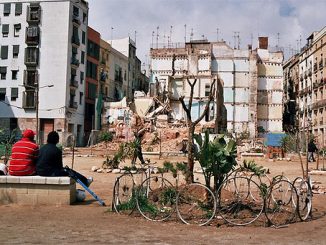
popular celebrations


The Secret
In the middle of January, many neighbourhoods of Naples still celebrate the ritual of the cippo di Sant’Antonio. After New Year’s Day the young boys search the whole city for firewood, also very far from their neighbourhoods. Every gang gathers its woods in a secret place – “il segreto” – to protect them from the raids of the other gangs; they wait for the day of the bonfire, among the frenzy of the search for wood, and the clashes among the gangs, sometimes real, sometimes imaginary, to defend the treasure from the attacks of the “enemies”. Everything happens in the streets, almost twenyfour hours a day: at morning they often skip school, by night they guard the hiding place. To accomplish their aim, the gangs pass over all the obstacles, either if it is their neighbours complaining for the yellings, or the police threatening them to confiscate the firewood. At a closer look, though, an internal set of rules can be found: codes and habits that are preserved from one generation to another. They are the same children that in school appear empty, lazy, apathetic, or the opposite, uncontrollable and agitated. During the days of the “cippo” you see them passionate, interested and disciplined. In the adventurous game they built with their own hands, they appear transformed, until the final catharsis arrives: when the fire is lit, they dance around it, singing, and throwing in the flames the firecrackers and their own clothes.
- IL SEGRETO (2013), a film by cyop&kaf about the ritual of the “cippo” in Naples’ Quartieri Spagnoli neighbourhood; special mention of the Jury at the Torino Film Festival, selected by Paris international festival Cinema du Réel [trailer][webpage][review in Quinlan]
- “La sfida del cippo e la città alla finestra“, by Luca Rossomando, Repubblica Napoli 1/15/2013 [here also translated into spanish], and “Il segreto di Sant’Antonio“, Napoli Monitor n. 53, march 2013.
- cyop&kaf generally paints, even if at times it stumbles on writing, urbanism, photography. When it took a videocamera for the first time, it had already spent three years before in a dialogue with Naples’ Quartieri Spagnoli. The first fruit of that long work was a book, QS, then a movie, Il segreto: two pieces-synthesis, that together try to account the complexity of a neighbourhood corroded by prejudice. To look behind and inside the appearance, often brutal, of things. See also the video Quore Spinato [trailer] and the reportage Fuoco e fiamme [link]
- Napoli Monitor, review of reportages, drawings, researches and chroniques, explaining Naples and other cities since 2007 [webpage]
A mediados de enero, en muchos barrios de Nápoles se celebra aún <strong>el ritual del <em>Cippo di Sant’Antonio</em></strong>. Después de las fiestas de año nuevo, los chavales empiezan a buscar leña para quemar, incluso muy lejos de sus barrios. Cada pandilla acumula su leña en un escondite – <em><strong><a href=”http://www.cyopekaf.org/il-segreto/#1″ target=”_blank”>il segreto</a></strong></em> – para protegerla de los asaltos de las pandillas de otros barrios. La espera del día de la hoguera, el 17 de enero, se consuma en búsquedas frenéticas y en las peleas, a veces reales, otras veces imaginarias, para defender el tesoro de los “enemigos”. <strong>Todo acontece en la calle, casi venticuatro horas al día</strong>; por la mañana se salta la escuela, por la noche se hacen turnos para vigilar el escondite. Para llegar al objetivo, las bandas están dispuestas a pasar por encima de todo, sean los vecinos del barrio que se quejan del ruido, sea la policía que amenaza con secuestrarlo todo. Observando más de cerca, pero, se descubren reglas y códigos de comportamiento que se transmiten de una generación a la otra:<strong> son los mismos niños que en el colegio aparecen vacíos, perezosos, desmotivados, incontenibles e irrequietos; en los días del <em>cippo</em> en cambio se los ve apasionados, atentos y disciplinados</strong>. En el juego aventuroso que han construido con sus manos aparecen transformados, hasta la catársis final, cuando se enciende el fuego y se baila, cantando y tirando en las llamas los petardos y la ropa.
<ul>
<li><strong>IL SEGRETO</strong> (2014), una película de <strong>cyop&kaf</strong> sobre el ritual del <em>Cippo </em>en el barrio <em>Quartieri Spagnoli</em> de Nápoles; de una idea de <strong>Luca Rossomando</strong>. Mención especial del jurado en el <a href=”http://www.torinofilmfest.org/?action=article&id=427″ target=”_blank”>Torino Film Festival</a>, seleccionado para el festival internacional <em>Cinema du Réel</em>, Paris <strong>[<a href=”http://www.youtube.com/watch?v=s0pPPZpHEV0″ target=”_blank”>trailer</a>][<a href=” http://www.cyopekaf.org/il-segreto/#1″ target=”_blank”>página web</a>][<a href=”http://quinlan.it/2013/11/24/il-segreto/” target=”_blank”>reseña en <em>Quinlan</em></a>]</strong></li>
<li>”<a href=”http://napolimonitor.it/2014/01/16/24309/la-sfida-del-cippo-e-la-citta-alla-finestra.html” target=”_blank”>La sfida del cippo e la città alla finestra</a>”, de <strong>Luca Rossomando</strong>, <em>Repubblica Napoli </em>15/1/2013, y “<a href=”http://napolimonitor.it/2014/02/07/24493/il-segreto-di-cyopkaf-la-prima-napoletana.html” target=”_blank”>Il segreto di Sant’Antonio</a>”, <em>Napoli Monitor</em> n. 53, marzo 2013. <strong>
</strong></li>
<li><strong>cyop&kaf </strong>dibuja, aunque a veces tropieza en la escritura, en la urbanística, en la fotografía. Cuando ha cogido la cámara de video por primera vez, llevaba tres años dialogando con el barrio <em>Quartieri Spagnoli</em> de Nápoles. El fruto ha sido primero un libro, <a href=”http://www.cyopekaf.org/books/qs-un-libro-dai-quartieri-spagnoli” target=”_blank”>QS</a>, y ahora una película, dos obras-síntesis que juntas intentan dar cuenta de la complejidad de un barrio corroído por prejuicios. Para mirar detrás y dentro la aparencia a menudo brutal de las cosas. <strong>Ver también el vídeo <em>Quore Spinato</em> [<a href=”http://vimeo.com/84214894″ target=”_blank”>trailer</a>] y el fotoreportaje </strong><strong><em>Fuoco e fiamme</em> [<a href=”http://napolimonitor.it/fotoreportage/quartieri-spagnoli-fuoco-e-fiamme” target=”_blank”>link</a>]</strong><strong> </strong></li>
<li><strong>Napoli Monitor</strong>, revista de reportajes, investigación, dibujos y crónicas, activa desde 2007 [<a href=”http://napolimonitor.it/” target=”_blank”>página web</a>]</li>
</ul>

Where there be dragons: Multiple modernities in Kathmandu
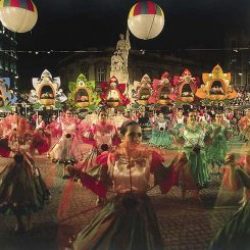
Two cities in the same Lisbon

Where the salt water meets the fresh: les Saintes Maries de la Mer
More on popular celebrations: in may, in the village of french midi les Saintes-Maries-de-la-Mer (Camargue), an extraordinary strange celebration takes place, and gypsies have an important part in it. Together with the procession for the two “canonical” saints, Saint Salomé and Saint Jacobé, gypsies from all France and other parts of Europe gather for the procession of Santa Sara, Sara Kali, or Sara the black: who officially is only the servant to the other two saints, but that the gypsies promoted as their patron saint, and that they carry into the sea. This celebration was invented in the end of the XIX century to promote turism and save a depressed region from the effects of massive migration; today it is a strange festival “in disguise”, during which both gypsies, turists and camarguaises fully entered some kind of role play, with neither shame nor complexes. For three days, gypsies with high-class caravans draw their alliances and organize marriages, and settle just opposite to the folkloric carriages that the locals organize for turists. Everybody adopts for three days the identity that the others project on them, as they are all playing, just for partying, for singing and dancing regardless of their traditions and their original musical styles. Flamenco mixes with other musics, as the gypsies with non-gypsies, just like the fresh waters of river Rhone meet the salt water of the sea, and aigues mortes of Camargue melt into the live waters of the Mediterranean.
- Marc Bordigoni (2002-3), “Le ‘pèlerinage des gitans’, entre foi, tradition et tourisme” Ethnologie française, 2002/3, vol.32, pp. 489-501.
- Among the most assiduous invitees of Santa Sara’s celebration there is the romanés band Urs Karpats, here live in 2010, known also as Ursarii, or bear tamers
- Great video about the celebration and Santa Sara, with music by Urs Karpaz: TSIGHINDIA SARA KALI :: see also Kali Sara by Latcho Drom
- Sara Kali, i.e. Sarah the Black, is not recognized as saint by any official church; the fact that her statue wears clothes is a sign of popular religion – it is the devotion of the gypsies with canonizes her as holy. Actually her statue wears many dresses one upon the other, as to symbolize the extreme devotion of her devotees. Many connect her faith with indian goddess Kali, that is also dumped underwater in an annual celebration under the form of Durga.
[audio: http://periferiesurbanes.org/wp-content/uploads/2013/01/6Rumba-gitana.mp3] Rumba gitana in Santes Maries de la Mer, recorded by ethnomusicologist Roberto Leydi in 1968…

Calabrian contradictions: culture as an excuse
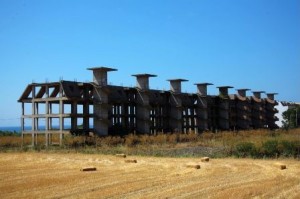 The traditional feast is like a litmus test: it changes naturally as the group that takes part in it changes, writes Angelo Maggio, Calabrian photographer after participating to the festa della Vergine at Polsi some years ago. Popular feasts change, tradition is reinvented and rewritten, according to new needs. After the nineties, in Calabria (Italy), the "second folk revival" (studied by australian anthropologist Stephen Bennetts), converted festivals in an excuse to attract tourists and money to small villages mostly depopulated: but this commercialization reduces Calabrian popular culture to "tarantelle", excluding all the rest of local popular traditions, that end up homologated in a common regional-popular denominator. At the same time, much more dangerous manipulations are taking place. A series of sinister individuals linked to mafia "clans" are publishing articles, books and records presenting 'ndrangheta (Calabrian mafia) as a "cultural" phenomenon, linked to folklore and popular traditions of Calabria, thus giving a kind of ethnic legitimacy to the cruelty of clans in front of public opinion, even internationally. And meanwhile, local anthropologists keep classifying ethnomusicological variants, and show little concern to all this public manipulations of their object of study.
The traditional feast is like a litmus test: it changes naturally as the group that takes part in it changes, writes Angelo Maggio, Calabrian photographer after participating to the festa della Vergine at Polsi some years ago. Popular feasts change, tradition is reinvented and rewritten, according to new needs. After the nineties, in Calabria (Italy), the "second folk revival" (studied by australian anthropologist Stephen Bennetts), converted festivals in an excuse to attract tourists and money to small villages mostly depopulated: but this commercialization reduces Calabrian popular culture to "tarantelle", excluding all the rest of local popular traditions, that end up homologated in a common regional-popular denominator. At the same time, much more dangerous manipulations are taking place. A series of sinister individuals linked to mafia "clans" are publishing articles, books and records presenting 'ndrangheta (Calabrian mafia) as a "cultural" phenomenon, linked to folklore and popular traditions of Calabria, thus giving a kind of ethnic legitimacy to the cruelty of clans in front of public opinion, even internationally. And meanwhile, local anthropologists keep classifying ethnomusicological variants, and show little concern to all this public manipulations of their object of study. 
Shift Happens! Critical Mass at 20
 The Critical Mass is an “organised coincidence" of cyclists that periodically celebrate a collective bike ride in the streets; its purpose is to show to the society the great advantages that bicycles could provide to urban mobility. In the occasion of the 20th anniversary of the first Critical Mass in San Francisco, one of its pioneers, Chris Carlsson, together with other contributors, edited the book Shift Happens. Critical Mass at 20, a collection of experiences and essays from some of the over 300 cities of the world in which the event reached an autonomous life, after that first bicycle ride. This is the meaning of the expression critical mass - the number of participants needed for phenomenon to start moving and growing by itself. The Critical Mass does'nt ask, it builds, giving form to a livable city through its own praxis. The presentation of the book in Madrid - where every last thursday of the month a Bicicrítica is held through the center of the city, while ten more happen in other neighborhoods and municipalities (like Fuenlabrada, Tres Cantos, Alcalá de Henares, Moratalaz, Ciudad Lineal) - was the occasion for a radio debate in "Carne Cruda", RN3, for the participation of the book's editors in a bicicrítica (read here Carlsson's impressions) and for the presentation of another book of his "Nowtopia, How Pirate Programmers, Outlaw Bicyclist and Vacant-Lot Gardeners Are Inventing the Future Today", in Traficantes de Sueños bookshop (here the audio of the event). Shift Happens's chapter on Madrid is the summary of an ethnografic article on bicycle repair workshops inside the occupied social centers of Madrid, that can be downloaded entirely from the link below.
The Critical Mass is an “organised coincidence" of cyclists that periodically celebrate a collective bike ride in the streets; its purpose is to show to the society the great advantages that bicycles could provide to urban mobility. In the occasion of the 20th anniversary of the first Critical Mass in San Francisco, one of its pioneers, Chris Carlsson, together with other contributors, edited the book Shift Happens. Critical Mass at 20, a collection of experiences and essays from some of the over 300 cities of the world in which the event reached an autonomous life, after that first bicycle ride. This is the meaning of the expression critical mass - the number of participants needed for phenomenon to start moving and growing by itself. The Critical Mass does'nt ask, it builds, giving form to a livable city through its own praxis. The presentation of the book in Madrid - where every last thursday of the month a Bicicrítica is held through the center of the city, while ten more happen in other neighborhoods and municipalities (like Fuenlabrada, Tres Cantos, Alcalá de Henares, Moratalaz, Ciudad Lineal) - was the occasion for a radio debate in "Carne Cruda", RN3, for the participation of the book's editors in a bicicrítica (read here Carlsson's impressions) and for the presentation of another book of his "Nowtopia, How Pirate Programmers, Outlaw Bicyclist and Vacant-Lot Gardeners Are Inventing the Future Today", in Traficantes de Sueños bookshop (here the audio of the event). Shift Happens's chapter on Madrid is the summary of an ethnografic article on bicycle repair workshops inside the occupied social centers of Madrid, that can be downloaded entirely from the link below.
- Elisabeth LORENZI (2010) “Centro social en movimiento. Los talleres de auto-reparación de bicicletas en espacios autogestionados” in Mario Domínguez, Miguel Ángel Martínez, Elísabeth Lorenzi, Okupaciones en Movimiento. derivas, estrategias y políticas. Madrid: Tierradenadie [ENLACE]
- Web of Bicios@s collective in Barcelona, and of bicitaller of "edificio 15O"
- web of the Critical Mass in Madrid: Bicicrítica
- The final presentation of "Shift Happens" in a bookshop in San Francisco will be on september 26th, the day of the anniversary, and will be part of a series of activities that will attract to the city cyclists from different places.

Recipes for interculturality from Bilbao
 Arroces del Mundo, Munduko Arrozak, is a popular fiesta being held since 2004 in San Francisco neighborhood, Bilbao (Basque country) . This barrio, apart from the center for the estuary and the railway, is four times more populated than the rest of the city; it has always been stigmatized as a ghetto, related with prostitution, considered a marginal part of the city where the immigrant live, and recently is becoming to be partially gentrified. The fiesta is the result of a patient networking that the Coordinadora de Grupos de Bilbao la Vieja, San Fraencisco y Zabala had been doing for years: this organization was born to influence in the Renewal Plan designed by the City Council, and is made of groups and individuals who had already done projects of social communication in the neighborhood. The idea of the fiesta serves both to denounce the abandon of the neighborhood, and to aim at the construction of intercultural relationships through autonomy and self-organization: the organizers of the event stress that as many people are involved, as less conflicts and incidents ocurr - with the practice, this undermines the securitarian discourse used by the authorities to increase police presence in San Francisco neighborhood.
Arroces del Mundo, Munduko Arrozak, is a popular fiesta being held since 2004 in San Francisco neighborhood, Bilbao (Basque country) . This barrio, apart from the center for the estuary and the railway, is four times more populated than the rest of the city; it has always been stigmatized as a ghetto, related with prostitution, considered a marginal part of the city where the immigrant live, and recently is becoming to be partially gentrified. The fiesta is the result of a patient networking that the Coordinadora de Grupos de Bilbao la Vieja, San Fraencisco y Zabala had been doing for years: this organization was born to influence in the Renewal Plan designed by the City Council, and is made of groups and individuals who had already done projects of social communication in the neighborhood. The idea of the fiesta serves both to denounce the abandon of the neighborhood, and to aim at the construction of intercultural relationships through autonomy and self-organization: the organizers of the event stress that as many people are involved, as less conflicts and incidents ocurr - with the practice, this undermines the securitarian discourse used by the authorities to increase police presence in San Francisco neighborhood. 
Madonna dell’Arco
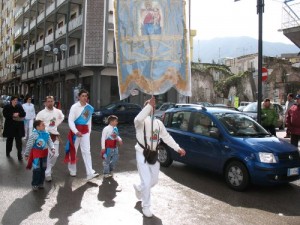 On Eastern Monday, in Sant'Anastasia, Napoli, one of the most interesting processions in Italy takes place, the fujenti gathering in the sanctuary of Madonna dell'Arco. Here's a Here's a short video shot in 2008.
And an audio collage of our recordings inside the sanctuary, also in 2008. [audio:http://periferiesurbanes.org/wp-content/uploads/2012/04/madonna_dell_arco_2008.mp3]
More info: a photoreportage by Mario Spada :: a website about the event, (S.Orsola University, Napols).
On Eastern Monday, in Sant'Anastasia, Napoli, one of the most interesting processions in Italy takes place, the fujenti gathering in the sanctuary of Madonna dell'Arco. Here's a Here's a short video shot in 2008.
And an audio collage of our recordings inside the sanctuary, also in 2008. [audio:http://periferiesurbanes.org/wp-content/uploads/2012/04/madonna_dell_arco_2008.mp3]
More info: a photoreportage by Mario Spada :: a website about the event, (S.Orsola University, Napols). 
Carnival King of Europe: against the domestication of the festival
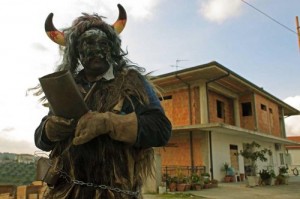 "Carnival has often provided an outlet for popular expressions of discontent with the ruling classes, and was actually banned in Spain during Franco’s Fascist dictatorship, under the pretext that the Carnival practice of disguising one’s identity with masks might provide cover for leftist insurgents to launch surprise guerrilla attacks.". Though Carnival King has been tamed almost all over Europe, it could come back to life in other continents of the world. A group of activists based in Fremantle (Perth, Australia) propose since 2004 a Carnival festival in the ancient European style: irriverent, nonconformist, countercultural. Meanwhile, in some parts of the old continent, Carnival is taking back its ancient value as an occasion for social protest.
"Carnival has often provided an outlet for popular expressions of discontent with the ruling classes, and was actually banned in Spain during Franco’s Fascist dictatorship, under the pretext that the Carnival practice of disguising one’s identity with masks might provide cover for leftist insurgents to launch surprise guerrilla attacks.". Though Carnival King has been tamed almost all over Europe, it could come back to life in other continents of the world. A group of activists based in Fremantle (Perth, Australia) propose since 2004 a Carnival festival in the ancient European style: irriverent, nonconformist, countercultural. Meanwhile, in some parts of the old continent, Carnival is taking back its ancient value as an occasion for social protest.